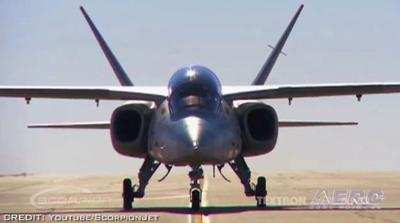Fri, Apr 11, 2014
Aircraft Demonstrates Performance From 120 To 310 Knots Calibrated Airspeed
Textron AirLand's Scorpion has completed 50 hours of flight time since the start of flight testing in December 2013, the company said Wednesday. The objective of recent flights has been to gather data about the aircraft’s performance at various speeds, altitudes and climb rates, as well as to assess the responsiveness of Scorpion’s avionics, flight controls and landing system.

The pilots report that the aircraft is nimble and agile with plenty of power, including single engine climbs. Scorpion has very good low speed characteristics. It handles very well in the landing pattern and is stable when in the landing configuration. “The aircraft systems have performed well within the expected parameters, with very few issues,” said Scorpion’s chief engineer, Dale Tutt. “This is a significant benefit of using mature, non-developmental systems: in addition to reducing the overall development time of the prototype aircraft, the systems have proven to be very reliable.”
Results of the test program to date:
- 50 hours total flight time, across 26 separate flights
- Envelope tested: Flight Level 300 (30,000 ft.), 310 KCAS, 0.72 Mach, +3.7 g-force/-0.5 g-force
- Maximum airspeed tested: 430 KTAS
- Single-engine climbs
- Stall speeds <90 KCAS
- Single engine shutdown and restart, in-flight
- Demonstration of low-speed aircraft interception mission
Test pilot Dan Hinson added, “The flight control systems are powered by dual hydraulic systems based on the Citation X business jet, and have performed flawlessly. In the event of a loss of both hydraulic systems, the airplane can be flown in manual reversion.”

The Avionics Systems are also non-developmental and performing well. The system is not highly integrated to maintain affordable life cycle costs, so the Scorpion testing team is able to easily make changes to the system without causing problems in other areas. “We routinely make software updates to the avionics system in days, not months,” said Tutt.
The Scorpion testing program remains on pace to complete 300-400 test hours this year, which will require about 150 flights. This is expected to include a number of international flights, pending the standard approvals.
(Images provided by Textron AirLand)
More News
Airport Marking Aids Markings used on runway and taxiway surfaces to identify a specific runway, a runway threshold, a centerline, a hold line, etc. A runway should be marked in ac>[...]
"It is extremely difficult, if not impossible, for manned aircraft to see a drone while conducting crop-enhancing and other aerial applications at low altitudes and high speeds. We>[...]
Aero Linx: The Skyhawk Association The Skyhawk Association is a non-profit organization founded by former Skyhawk Pilots which is open to anyone with an affinity for the A-4 Skyhaw>[...]
“The T-54A benefits from an active Beechcraft King Air assembly line in Wichita, Kansas, where all required METS avionics and interior modifications are installed on the line>[...]
Aero Linx: Aerostar Owners Association The Association offers the Aerostar Owner a unique opportunity to tap an invaluable source of information concerning the care and feeding of >[...]
 ANN's Daily Aero-Term (04.28.24): Airport Marking Aids
ANN's Daily Aero-Term (04.28.24): Airport Marking Aids Aero-News: Quote of the Day (04.28.24)
Aero-News: Quote of the Day (04.28.24) ANN's Daily Aero-Linx (04.28.24)
ANN's Daily Aero-Linx (04.28.24) Aero-News: Quote of the Day (04.29.24)
Aero-News: Quote of the Day (04.29.24) ANN's Daily Aero-Linx (04.29.24)
ANN's Daily Aero-Linx (04.29.24)




